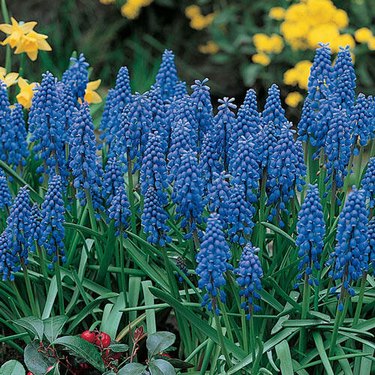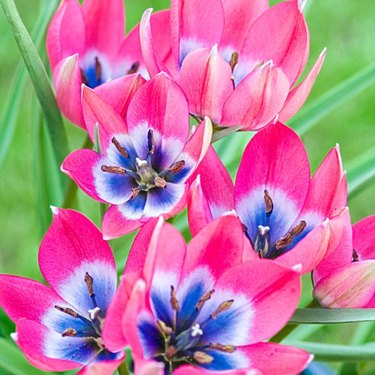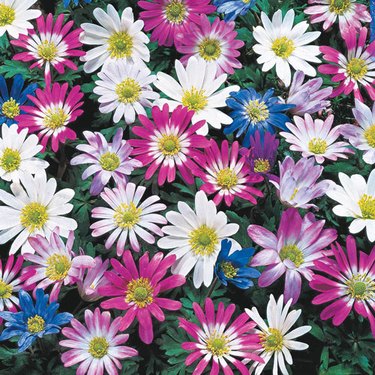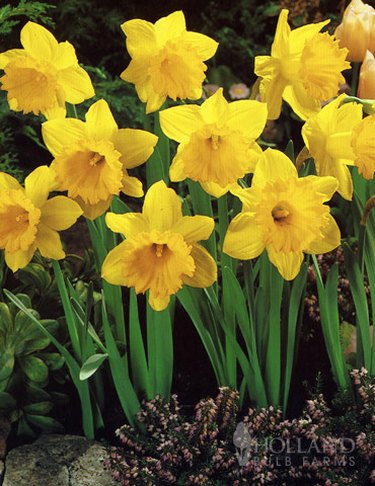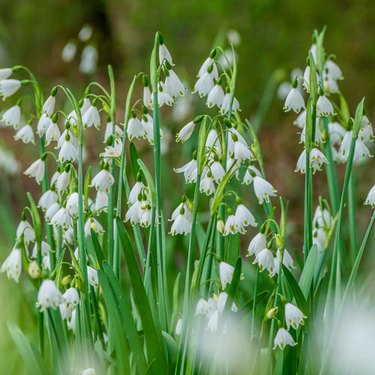
Nothing brings cheer and a colorful feel to landscapes like a garden filled with bright and vibrant blooms. One of the easiest ways to fill your gardens with greenery and color is by planting fall bulbs. Once spring rolls around, the bulbs have sprouted and they're ready to showcase their good looks. Best of all, you have a vast and varied selection of fall bulbs that are guaranteed to meet every gardener's desire. In fact, one look at all the fall bulbs available and you'll probably find yourself wanting them all.
Whether you're looking to fill a mixed bed, a perennial garden, a flower bed, or border with delightful blooms, there's a fall bulb to fit your needs. Even novice gardeners will have a successful experience planting fall bulbs, provided they follow the specific bulb's requirement for planting. Then, the biggest chore is sitting back and watching everything spring to life, filling your garden with a rainbow of colorful springtime flowers!
Video of the Day
Video of the Day
We've outlined some important considerations for successfully selecting and planting your fall bulbs. There's also a list of just a few of the bulbs available for planting in fall that are guaranteed to brighten your landscape with a springtime flower fest.
What to Consider When Planting Fall Bulbs for Spring Flowers
Selecting Hardy Bulbs: When selecting fall bulbs to plant for springtime blooms, only choose types that are hardy growing in your specific region. Familiarize yourself with your specific USDA plant hardiness zone, as not every fall bulb will perform well in every hardiness zone. Some fall bulbs prefer growing in cooler regions and won't grow well in warmer locales. Check the bulb's description for the specific USDA zones it grows well in.
Get the Bed Ready: Select an area of your garden that receives sun the majority of the day and prepare the area before planting your bulbs. Bulbs perform best in fertile, well-drained soil that is loose. Remove any unwanted growth from the bed. If needed, spread 6 inches of compost or well-rotted manure over the planting site to improve the soil's fertility and then work it into the soil about 6 inches. Otherwise, loosen the planting site's soil so the fall bulbs have an easier time sprouting.
Plant at the Right Time: The majority of fall bulbs require a cooling period for blooming in spring. In regions with cold winters, it's best to plant when the nighttime temperatures range between 40 degrees to 50 degrees Fahrenheit and before the ground freezes. However, if you live in an area with warmer winters where the ground doesn't freeze, store your fall bulbs in the refrigerator for about six to 10 weeks before planting.
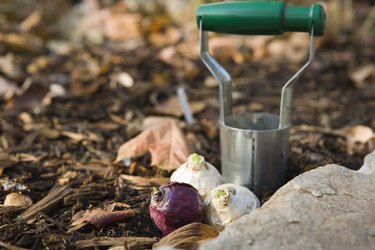
1. Spring Flowering Crocus Bulbs
‘King of the Striped’ Giant Crocus (Crocus vernus), 25-Count
Holland Bulb Farm's 'King of Striped' crocus has been filling gardens with delightful colors since the 1880s. This early spring bloomer has white petals striped in purple with yellow centers and is hardy growing in USDA zones 3 through 8. Plants grow anywhere from 3 to 6 inches tall. The early flowers sometimes pop their heads out of the soil while snow is still on the ground. The bulbs perform as perennials and make attractive additions to borders. They're perfect for naturalizing and can also be forced. These plants also make good additions to butterfly and pollinator gardens, as the blooms attract butterflies and hummingbirds, but are deer-resistant. Plant the bulbs in a sunny site with well-drained soil and plant 2 to 3 inches deep and 2 to 4 inches apart.
2. Spring Flowering Hyacinth Bulbs
‘Super Sak’ Blue Grape Hyacinth (Muscari armeniacum), 50-Count
With Breck's 'Super Sak' blue grape hyacinth bulbs you'll have plenty to fill your beds with spring color as you get 50 bulbs in a package. The flower stalks fill with bell-shaped clusters of cobalt blue flowers that look striking against the deep green foliage on 6- to 8-inch plants. Plants are sure to get the eye's attention in the garden when they bloom in mid-spring. These hyacinths are easy to grow and versatile, growing well in USDA zones 4 through 9. They perform as perennials and prefer a sunny or partially shady site protected from the intense afternoon sun. Plant the bulbs 3 inches deep and 2 to 3 inches apart. Plants attract bees but are deer-resistant.
3. Spring Flowering Tulip Bulbs
‘Little Beauty’ Tulip (Tulipa spp.), 10-Count
Michigan Bulb's 'Little Beauty' tulip definitely lives up to its name with its striking, brightly colored flowers bursting into bloom in mid-spring. The tulips have an open form with blue and white throats and outer pointy petals dressed in vibrant pink. Blooms stand out against the slender green foliage on 6-inch plants. These showstoppers are sure to grab attention planted in mass, used in borders, naturalizing an area or planted in pots. The spring bloomers return year after year, and are a winner of the Award of Garden Merit. Novices will find success growing 'Little Beauty' in USDA zones 3 through 8 and in well-drained soil located in full sun to partial shade. Plant the tulip bulbs 4 inches deep and spaced 3 inches apart.
4. Spring Flowering Allium
Giant Allium (Allium giganteum), 3-Count
If you're looking for a fall bulb producing statement-making large plants and flowers in spring, then you won't be disappointed with Holland Bulb Farm's giant allium bulbs. Blooming in late spring, long, thin stalks sometimes growing over 3 feet tall fill with round, 6-inch diameter blooms with a mass of tiny purple flowers. The long-lasting blooms are popularly used as dried or cut flowers. Each bulb produces anywhere from two to three flowers and attracts hummingbirds and butterflies, making it a good addition to pollinator gardens. The allium is deer-resistant. For the best growth, plant the allium in well-drained soil located in full to partial shade, planting the bulbs 4 to 6 inches deep and spaced 4 to 8 inches apart.
5. Spring Flowering Fritillaria Bulbs
Orange Fritillaria (Fritillaria imperialis), 3-Count
For a spring blooming bulb that's a bit different and will add some exotic appeal to your garden, Eden Brothers' orange fritillaria fits that description well. The fall planted bulbs are hardy in USDA zones 3 through 7. In mid- to late-spring, tall flower stalks sometimes over 3 feet tall bloom. Fragrant orange bell-shaped flowers hang upside down, forming a ring at the top of the stalk with a clump of short green leaves at the top's center (almost looking like a tuft of unruly hair). Plants are drought-tolerant and make a great addition to butterfly and pollinator gardens attracting bees, hummingbirds and butterflies. They'll grow best planted in full sun to a partially shady location in well-drained soil. Plant the bulbs 10 to 12 inches deep spaced about a foot apart.
6. Spring Flowering Windflowers
Mixed Color Windflowers (Anemone blanda), 25-Count
Hardy in USDA zones 4 through 9, Michigan Bulb Co.'s windflowers are sure to bring a delightfully cheery appeal to your gardens with their early- to mid-spring blooms. This mixture of fall-planted bulbs fills the garden with a blanket of daisy-like blooms, ranging in colors of white, blue, pink and purple with a showy yellow stamen center. The eye-catching blooms really stand out against the dark green fern-like foliage. The plant's low-growing nature (it only reaches about 6 inches tall) makes it the perfect addition to rock gardens, planted in mass, or used in a border or as a ground cover. Plant the spring bloomers in well-drained soil situated in full sun to partial shade and plant the bulbs about 3 inches deep and spaced 3 inches apart.
7. Spring Flowering Daffodils
‘Dutch Master’ (Narcissus spp.), 50-Count
Nothing quite hails the coming of spring like daffodils, and the 'Dutch Master' fall bulbs from Holland Bulb Farms won't leave you disappointed. Hardy in USDA zones 3 to 8, in mid-spring, large trumpet-shaped blooms in vibrant yellow bloom on tall 18-inch stalks highlighted with long, strap-like green foliage. These daffodils are sure to bring a cheery appeal anywhere they're growing and will pump up the color in your flower beds, borders or containers. They are even suitable for indoor forcing as well as cut flowers. Perhaps best of all, they are resistant to deer, squirrels and rabbits. 'Dutch Master' daffodils grow the best planting in a sunny to partially shady location in well-drained soil. Plant the bulbs 6 to 8 inches deep, spaced about 6 inches apart.
8. Spring Flowering Anemone
‘Blue Shades’ Anemone (Anemone blanda), 10-Count
Hardy in USDA zones 5 through 9, 'Blue Shades' anemone bulbs from Breck's will definitely hail the coming of spring with a blanket of intense blue. Blooming in early- to mid-spring, 2-inch blue daisy-like flowers with yellow centers burst onto the scene and are sure to get noticed. This low-growing perennial fall bulb with fern-like green foliage works perfectly as a ground cover—thickly filling in bare spots, used in rock gardens, or to add robust color around deciduous trees. For the best growth, plant in well-drained soils located in full sun to partial shade and plant the bulbs 3 inches deep and 3 inches apart.
9. Spring Flowering Giant Snowflake
‘Gravetye Giant’ (Leucojum aestivum), 8-Count
Adding an elegant look to gardens located in USDA zones 4 through 8, Michigan Bulb's giant snowflake bulbs produce their delightful blooms in mid- to late-spring. This fast-growing plant adds charm to rock gardens and borders, or it can be used around ponds and water features. You could opt to plant it in mass, use it to naturalize an area, or plant it in containers. The enchanting small white and green bell-shaped blooms dangle downward from their flowering stalks and are said to have a fragrance resembling chocolate. The blooms are suitable for cut flowers. The green grass-like leaves stand out against the white blooms on plants that average around 18 to 30 inches tall. Giant snowflake performs best in full sun to partial shade, situated in well-drained soil and given medium amounts of moisture. Plant the bulbs about 6 inches deep spacing multiples 5 to 6 inches apart.

